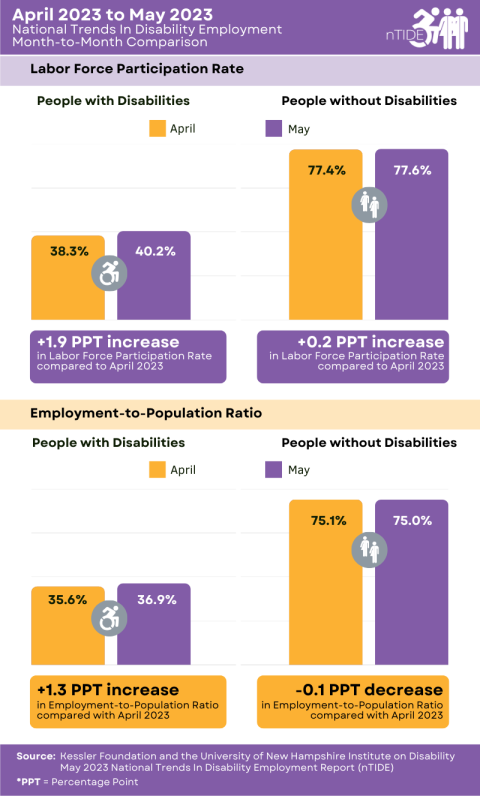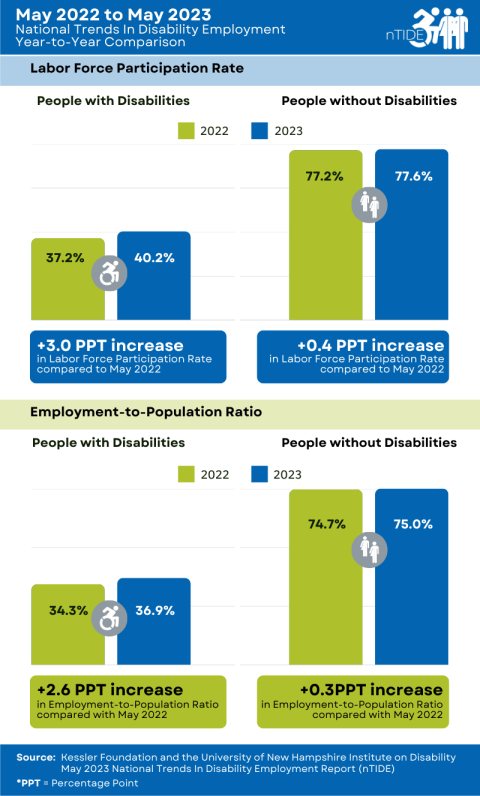
Join us for the next nTIDE Lunch & Learn Webinar featuring guest presenter Jereme Wilroy, Director of Research at Lakeshore Foundation and Co-director of the UAB Spinal Cord Injury Model Systems.
nTIDE May 2023 Jobs Report: Job numbers rebound bringing people with disabilities close to previous high in employment
National Trends in Disability Employment (nTIDE) – Issued semi-monthly by Kessler Foundation and the University of New Hampshire
June 2, 2023 – In a sharp reversal, employment indicators rebounded for people with disabilities in May, according to today’s National Trends in Disability Employment – semi-monthly update (nTIDE), issued by Kessler Foundation and the University of New Hampshire’s Institute on Disability (UNH-IOD). Employment appears to be remaining strong despite the threats to the labor market posed by the debt ceiling crisis and ongoing efforts to control inflation.
Month-to-Month nTIDE Numbers (comparing April 2023 to May 2023)

This graphic compares the labor market indicators for April 2023 and May 2023, showing increases in the labor force participation rate for people with and without disabilities. The employment-to-population ratio increased markedly for people with disabilities and was unchanged for people without disabilities.
Based on data from the U.S. Bureau of Labor Statistics (BLS) Jobs Report released today, the employment-to-population ratio for working-age people with disabilities (ages 16-64), increased from 35.6 percent in April 2023 to 36.9 percent in May 2023 (up 3.7 percent or 1.3 percentage points). For people without disabilities (ages 16-64), the employment-to-population ratio decreased from 75.1 percent in April 2023 to 75.0 in May 2023 (down 0.1 percent or 0.1 percentage points). The employment-to-population ratio, a key indicator, reflects the percentage of people who are working relative to the total population (the number of people working divided by the number of people in the total population multiplied by 100).
“After last month’s fairly large decline in the employment-to-population ratio for people with disabilities, in May we see a rebound in the percentage of people with disabilities who are employed,” reported Megan Henly, PhD, Project Director at the UNH-IOD. “This increase brings the percentage employed close to the previous high observed in December of last year.”
With regard to labor force participation, the labor force participation rate for people with disabilities (ages 16-64) increased from 38.3 percent in April 2023 to 40.2 percent in May 2023 (up 5 percent or 1.9 percentage points). For people without disabilities (ages 16-64), the labor force participation rate also increased from 77.4 percent in April 2023 to 77.6 percent in May 2023 (up 0.3 percent or 0.2 percentage points). The labor force participation rate reflects the percentage of people who are in the labor force (working, on temporary layoff, on furlough, or actively looking for work in the last four weeks) relative to the total population (the number of people in the labor force divided by the number of people in the total population multiplied by 100).
“Consistent with the employment-to-population ratio, the labor force participation of people with disabilities also rebounded,” said John O’Neill, PhD, director of the Center for Employment and Disability Research at Kessler Foundation. “Their participation remains strong in spite of the Federal Reserve continuing to raise rates to slow the economy and the looming Federal debt crisis,” he added.
In May, among workers ages 16-64, the 6,097,000 workers with disabilities represented 4.1 percent of the total 150,244,000 workers in the U.S.
Year-to-Year nTIDE Numbers (comparing May 2022 to May 2023)

This graphic compares the labor market indicators for May 2022 and May 2023, showing increases for people with and without disabilities.
Compared to the same month last year, the labor force participation rate for people with disabilities (ages 16-64) increased from 37.2 percent in May 2022 to 40.2 percent in May 2023 (up 8.1 percent or 3.0 percentage points). For people without disabilities (ages 16-64), the labor force participation rate also increased from 77.2 percent in May 2022 to 77.6 percent in May 2023 (up 0.5 percent or 0.4 percentage points).
Regarding employment, the employment-to-population ratio for working-age people with disabilities (ages 16-64) increased from 34.3 percent in May 2022 to 36.9 percent in May 2023 (up 7.6 percent or 2.6 percentage points). For working-age people without disabilities, the employment-to-population ratio also increased from 74.7 percent in May 2022 to 75.0 percent in May 2023 (up 0.4 percent or 0.3 percentage points).
Ask Questions about Disability and Employment
Each nTIDE release is followed by an nTIDE Lunch & Learn online webinar. This live broadcast, hosted via Zoom Webinar, offers attendees Q&A on the latest nTIDE findings, provides news and updates from the field, and features invited panelists who discuss current disability-related findings and events.
On June 2, 2023, at 12:00 pm Eastern, Jereme Wilroy, PhD, Director of Research at Lakeshore Foundation and Project Co-director of the UAB Spinal Cord Injury Model System, joins Drs. O’Neill and Henly, and Denise Rozell from the Association of University Centers on Disabilities (AUCD). Join our free Lunch & Learn live or visit the nTIDE archives at: ResearchonDisability.org/nTIDE.
Register now for our mid-month Deeper Dive into employment trends at nTIDE Deeper Dive - 6/23/2023 | Center for Research on Disability
